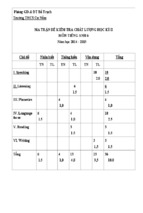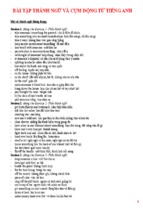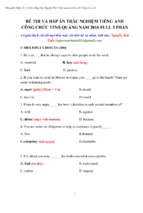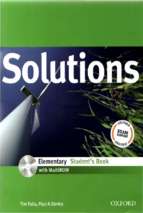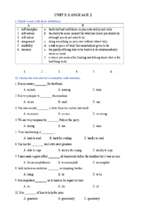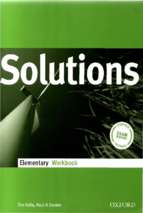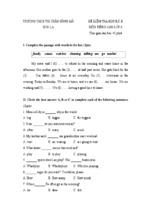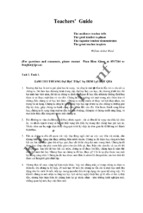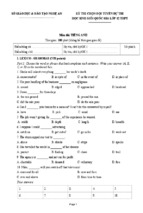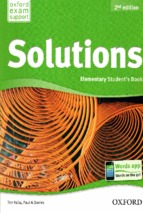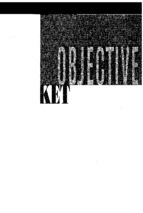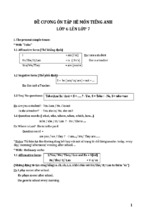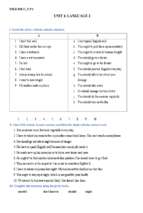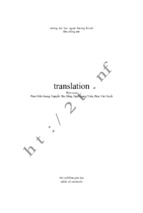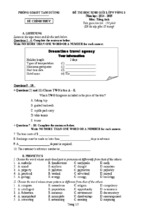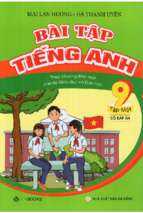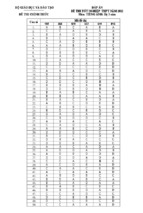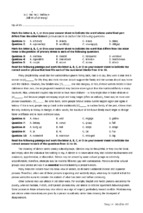Mô tả:
đề thi anh chuyên ngành y
BỘ ĐỀ ANH VĂN CHUYÊN NGÀNH Y HỌC KỲ I
(ĐÁP ÁN ĐÚNG LÀ ĐÁP ÁN A)
Mđ 1
**How do you say “bác sỹ phẫu thuật” in English?
## surgeon (ĐÁP ÁN)
## anaesthetist
## cardiologist
## consultant
** How do you say “bác sỹ chuyên khoa tim” in English?
## cardiologist (ĐÁP ÁN)
## surgeon
## anaesthetist
## consultant
** How do you say “dược sỹ” in English?
## pharmacist
## anaesthetist
## cardiologist
## consultant
** How do you say “hộ sinh” in English?
## midwife
## surgeon
## anaesthetist
## cardiologist
** How do you say “chuyên viên vật lý trị liệu” in English?
## physiotherapist
## surgeon
## cardiologist
## consultant
** How do you say “chuyên viên X quang” in English?
## radiologist
## surgeon
## anaesthetist
## cardiologist
** How do you say “nhân viên cấp cứu” in English?
## paramedic
## surgeon
## anaesthetist
## consultant
** How do you say “bác sỹ nhi khoa” in English?
## paediatrician
## surgeon
## anaesthetist
## cardiologist
** How do you say “y tá phụ mổ” in English?
## scrub nurse
## paediatrician
## surgeon
## anaesthetist
** How do you say “kỹ thuật viên gây mê” in English?
## anaesthetist
## scrub nurse
## paediatrician
## surgeon
** How do you say “kỹ thuật viên xét nghiệm” in English?
## lab technician
## anaesthetist
## scrub nurse
## paediatrician
**Which syllable is the word “receptionist” stressed on?
## second
## first
## third
## fourth
** Which syllable is the word “radiologist” stressed on?
## third
## second
## first
## fourth
** Which syllable is the word “anaesthetist” stressed on?
## second
## first
## third
## fourth
** Which syllable is the word “physiotherapist” stressed on?
## fourth
## second
## first
## third
** Which syllable is the word “paediatrician” stressed on?
## third
## second
## first
## fourth
** A _____ treats children.
## paediatrician
## midwife
## porter
## scrub nurse
** A _____ attends births and delivers babies.
## midwife
## paediatrician
## porter
## scrub nurse
** A _____ specializes in illnesses of the heart and blood vessels.
## cardiologist
## paediatrician
## porter
## scrub nurse
** A _____ moves equipment, furniture, patients, etc. around the hospital.
## porter
## cardiologist
## paediatrician
## scrub nurse
** A _____ takes X ray and other imagines.
## radiologist
## cardiologist
## paediatrician
## scrub nurse
** A scrub nurse _____ surgeons in the operating theatre.
## supports
## prepares
## performs
## examines
** A pharmacist _____ medicines to give to medical staff or patients.
## prepares
## supports
## performs
## examines
** A paramedic responds to emergencies and _____ first aid.
## gives
## prepares
## performs
## examines
** A surgeon _____ operations.
## performs
## supports
## prepares
## examines
** A lab technician _____ samples and tissues under a microscope.
## examines
## supports
## prepares
## performs
** How do you say “máy đo điện tim” in English?
## an ECG
## a microscope
## an exercise machine
## a bone plate
** How do you say “kính hiển vi” in English?
## microscope
## scales
## a dermabrader
## a dialysis machine
** How do you say “máy ly tâm” in English?
## a centrifuge
## neurological pinwheel
## paediatric spoon
## a scapel
** How do you say “máy tập” in English?
## an exercise machine
## an ECG
## a microscope
## a bone plate
** How do you say “cái cân” in English?
## scales
## microscope
## a dermabrader
## a dialysis machine
** How do you say “nẹp xương” in English?
##a bone plate
## neurological pinwheel
## paediatric spoon
## a scapel
** How do you say “máy cắt da” in English?
## a dermabrader
## microscope
## scales
## a dialysis machine
** How do you say “máy chay thận nhân tạo” in English?
## a dialysis machine
## a dermabrader
## microscope
## scales
** How do you say “thiết bị đo cảm giác” in English?
## neurological pinwheel
## a bone plate
## paediatric spoon
## a scapel
** How do you say “muỗng ăn của trẻ em” in English?
## paediatric spoon
## neurological pinwheel
## a bone plate
## a scapel
** How do you say “dao mổ” in English?
## a scapel
## paediatric spoon
## neurological pinwheel
## a bone plate
** How do you say “máy chụp X-quang” in English?
## an X-ray machine
## paediatric spoon
## neurological pinwheel
## a bone plate
** ________ is for monitoring the heart.
## An ECG
## A microscope
## An exercise machine
## A bone plate
** ________ is for examining tisues, samples, etc., very closely.
## Microscope
## Scales
## A dermabrader
## A dialysis machine
** ________ is for separating substances by spinning them.
## A centrifuge
## Neurological pinwheel
## Paediatric spoon
## A scapel
** ________ is for fixing a broken bone.
## A bone plate
## Neurological pinwheel
## Paediatric spoon
## A scapel
** ________ is for removing damaged skin.
## A dermabrader
## Microscope
## Scales
## A dialysis machine
** ________ is for cleaning the blood when the kidneys don’t work.
## A dialysis machine
## A dermabrader
## Microscope
## Scales
** ________ is for weighing substances.
## Scales
## A dialysis machine
## A dermabrader
## Microscope
** ________ is for building strength after injury.
## An exercise machine
## A dialysis machine
## A dermabrader
## Microscope
** ________ is for testing for sensation in nerves.
## Neurological pinwheel
## A bone plate
## Paediatric spoon
## A scapel
** ________ is for children to grip.
## Paediatric spoon
## Neurological pinwheel
## A bone plate
## A scapel
** ________ is for performing surgery.
## A scapel
## Paediatric spoon
## Neurological pinwheel
## A bone plate
** ________ dispenses medicines.
## Pharmacy
## Pathology
## Cardiology
## Physiotherapy
** ________ treats kidney diseases.
## Renal Unit
## Pathology
## Cardiology
## Physiotherapy
** ________ specializes in pregnancy and birth.
##Obstetrics
## Pathology
## Cardiology
## Physiotherapy
** ________ studies illnesses and analyses samples.
## Pathology
## Pharmacy
## Cardiology
## Physiotherapy
** ________ treats diseases of the skin.
## Dermatology
## Pathology
## Cardiology
##Physiotherapy
** ________ performs operations on patients.
## Surgery
## Pathology
## Cardiology
## Physiotherapy
** ________ designs special exercises for patients.
## Physiotherapy
## Pharmacy
## Pathology
## Cardiology
** ________ studies blood disorders.
## Haematology
## Pathology
## Cardiology
## Physiotherapy
** ________ treats bones.
## Orthopaedics
## Pathology
## Cardiology
## Physiotherapy
** ________ specializes in the heart.
## Cardiology
## Pharmacy
## Pathology
## Physiotherapy
** ________ deals with sick children.
## Paediatrics
## Pathology
## Cardiology
## Physiotherapy
** ________ treats disorders of the nervous system.
## Neurology
## Pathology
## Cardiology
## Physiotherapy
** Take a seat in the ______.
## waiting room
## registration
## initial assessment
## treatment
** When you are admitted to hospital, the first nurse you meet will be a specialist called ______.
## triage nurse
## nursing officer
## auxiliary nurse
## charge nurse
** The triage nurse will make ______ of your problem.
## an initial assessment
## waiting room
## registration
## treatment
**An initial assessment helps decide who is ______.
## a priority
## an initial assessment
## life-threatening
## treatment
** A patient with a ______ condition will see a doctor immediately.
## life-threatening
## decide
## treatment
## an initial assessment
** A nurse will get personal details from you and fill in a hospital ______ form.
## registration
## treatment
## cubicle
## priority
** When there is a free ______ a doctor will see you.
## cubicle
## hospital
## treatment
## waiting room
** The doctor will decide on the ______.
## treatment
## initial assessment
## registration
## cubicle
** The word “occupation” in the patient record means ______.
## job
## allergies
## next of kin
## intake
** The word “allergies” in the patient record means ______.
## bad reactions, for example to certain medications
## the amount of something you eat, drink, etc. regularly
## date of birth
## male / female
** The word “next of kin” in the patient record means ______.
## closest relative
## the amount of something you eat, drink, etc. regularly
## in each (day, week, etc.)
## male / female
** The word “intake” in the patient record means ______.
## the amount of something you eat, drink, etc. regularly
## bad reactions, for example to certain medications
## date of birth
## male / female
** The word “gender” in the patient record means ______.
## male / female
## bad reactions, for example to certain medications
## the amount of something you eat, drink, etc. regularly
## date of birth
** The word “medical history” in the patient record means ______.
## past illnesses and injury
## bad reactions, for example to certain medications
## the amount of something you eat, drink, etc. regularly
## not applicable
** The word “marital status ” in the patient record means ______.
## married / single / divorced / widowed
## bad reactions, for example to certain medications
## the amount of something you eat, drink, etc. regularly
## past illnesses and injury
**The abbreviation “GP” in the patient record means ______.
## family doctor
## number
## the amount of something you eat, drink, etc. regularly
## in each (day, week, etc.)
** The abbreviation “DOB” in the patient record means ______.
## date of birth
## in each (day, week, etc.)
## family doctor
## place of birth
** The abbreviation “n/a” in the patient record means ______.
## not applicable
## number
## family doctor
## date of birth
** The abbreviation “per” in the patient record means ______.
## in each (day, week, etc.)
## not applicable
## family doctor
## date of birth
** The abbreviation “no.” in the patient record means ______.
## number
## in each (day, week, etc.)
## family doctor
## date of birth
** ________ a clean, sharp needle with alcohol.
## Sterilize
## Make sure
## Puncture
## Remove
** ________ there is no glass or other foreign body in the wound.
## Make sure
## Sterilize
## Puncture
## Remove
** Use the needle to ________ the blister.
## puncture
## sterilize
## make sure
## remove
** Don’t ________ burnt clothing.
## remove
## make sure
## puncture
## treat
** ________ a main artery if necessary.
## Squeeze
## Remove
## Immerse
## Treat
** ________ the injured person lying down.
## Keep
## Remove
## Immerse
## Treat
** ________ the injured body part once the bleed has stopped.
## Immobilize
## Remove
## Immerse
## Swab
** ________ the person for shock.
## Treat
## Squeeze
## Remove
## Immerse
** Don’t ________ severe large burnt in cold water.
## immerse
## check for
## swab
## immobilize
** ________ signs of circulation.
## Check for
## Immerse
## Swab
## Immobilize
** ________ with Iodine or rubbing alcohol.
## Swab
## Immerse
## Check for
## Immobilize
** ________ antibiotic ointment and cover with a bandage.
## Apply
## Check for
## Immerse
## Immobilize
** Make sure you ________.
## use a sterile needle
## the patient is breathing
## the patient try to stand up
## the patient’s pulse again
** Don’t let ________.
## the patient try to stand up
## the patient is breathing
## use a sterile needle
## the patient’s pulse again
**Take ________.
## the patient’s pulse again
## the patient try to stand up
## the patient is breathing
## use a sterile needle
** What do ________?
## I count up to between breaths
## put the burnt area under running water
## the wound now
## I gives her
** Shall I bandage ________?
## the wound now
## I count up to between breaths
## put the burnt area under running water
## I give her
** Don’t ________!
## tie the bandage too tight
## the patient ís breathing
## the wound now
## I give her
** What dosage shall ________?
## I give her
## tie the bandage too tight
## put the burnt area under running water
## the wound now
** Where do I ________?
## have to apply the pads
## tie the bandage too tight
## put the burnt area under running water
## the wound now
** Should I ________?
## put the burnt area under running water
## to apply the pads
## the bandage too tight
## the wound now
**When shock occurs, the ________ is affected.
## central nervous system
## immune system
## intestines
## abdominal
** A person with shock, their temperature may be ________ low or high.
## abnormally
## abnormal
## respiratory
## dangerous
** A person with shock, ________ problems may develop.
## cardiovascular
## abnormally
## respiratory
## intestines
** When shock occurs, ________ can be high in the early stages.
## blood pressure
## coma
## respiratory
## intestines
** When shock occurs, gastrointestinal problems can cause ________ pain, nausea, vomiting or
diarrhoea.
## abdominal
## abnormally
## coma
## respiratory
** ‘Money that you will receive when you are old’ means ……
## pension
## skills
## overtime
## experience
** ‘study and practice to learn how to do a job’ means …
## basic training
## further studies
## more advanced learning
## trainee
**Written instructions on what drug to give a patient means _____
## prescription
## administrative staff
## patient record
## limb
** An arm or leg is ____
## limb
## heart
## head
## kidney
**A ____ responds to emergencies and give first aid.
## paramedic
## physiotherapist
## receptionist
## lab technician
** Exams and courses that you have taken is called ___
## qualification
## pension
## skills
## experiences
** Similar work that you have done before is called ______
## experience
## skills
## qualification
## further studies
** Level of scale is called ____
## pay scale
## overtime
## further studies
## pension
** _____ feels like a muscle is being squeezed.
## a cramping pain
## a gnawing pain
## a dull ache
## a shooting pain
** Past illnesses and injuries are called ____
## medical history
## allergies
## occupation
## next of kin
** Mistakes that result in death is called ____
## fatal errors
## amputate
## limb
## prescription
** Made somebody pay money as a punishment
## fined
## payment
## pension
## rewarding
**______ him CPR
## give
## check
## hold
## support
** _____ him mouth to mouth first.
## give
## check
## hold
## support
** ____ his nose closed.
## hold
## check
## give
## support
** _____ your hand on his check.
## put
## give
## set up
## check
** Check ____ signs of circulation.
## for
## in
## out
## to
** She wear a mask to _____ the area of burnt skin.
## protect
## prevent
## treat
## keep
** She used breathing exercises and gas and air to ____ the pain of childbirth.
## manage
## have
## suffer
## protect
**When you ____ a serious injury you may not feel pain immediately.
## suffer
## control
## treat
## prevent
** Does anything make _____?
## worse
## the pain feel better
## hurting
## hurt all the time
** Does it ____ ?
## hurt all the time
## does it hurt
## hurting
## it hurt
**When did it start ____?
##hurting
## does it hurt
## it hurt
## hurt all the time
** Does the pain ____ ?
## stay in one place or move around
## hurting all the time
##worse
##better
** Can you ____ ?
## describe the pain
## hurt all the time
## the pain describe
## all the time hurt
** A local anaesthetic will ____ you feeling any pain during the operation.
## prevent
## protect
## treat
## keep
** Are you still ____ pain ?
## in
## on
## at
## to
** I ____ a slight pain, just here in my right side.
## have
## has
## hurt
## ache
** “ comes and goes rhythmically” means _____
## a throbbing pain
## a sharp paina
## burning pain
## a stabbing pain
** “feels like it is eating you” means _____
## a gnawing pain
## a dull ache
## a shooting pain
## a cramping pain
** ‘travels fast along part of your body” means _____
## a shooting pain
## a dull ache
## a gnawing pain
## a cramping pain
** ‘is steady and not too painful’
## a dull ache
## a shooting pain
## a gnawing pain
## a cramping pain
** ________ happened to you ?
##What
##When
## Where
## How
** Where does _____?
##it hurt
## Mrs Hales is
## are you
## broken
** You’ve had an X-ray, _____
##haven’t you?
## aren’t you?
## didn’t you?
## isn’t it?
** Let’s have a look-swollen, _____
## isn’t it?
##aren’t you?
## are you?
## is it?
** You aren’t on any other medication, _____
## aren't you?
## are you?
## is it?
## isn’t it?
**What about _____?
##your head
## broken
## does it feel
## move your toes
**Children with asthma, cough and ____ when they breath out.
##wheeze
##sounds
## get
## coughing up
**A bad cough can _____ a child vomit.
## make
## give
## have
## accompanied
** I have to _____ quick decisions.
## make
## become
## deal with
## save
**A ______ pain comes and goes rhythmically.
##throbbing
## sharp
## burning
## shooting
**A ____ pain is strong and sudden.
##sharp
## dull
## gnawing
## cramping
**A _____ pain feels like fire.
##burning
## sharp
## dull
## gnawing
- Xem thêm -

